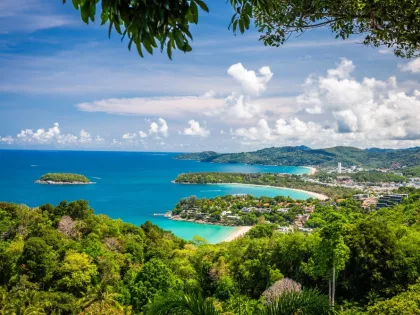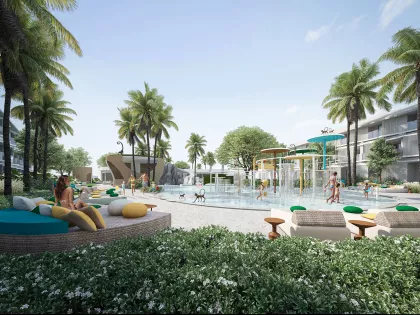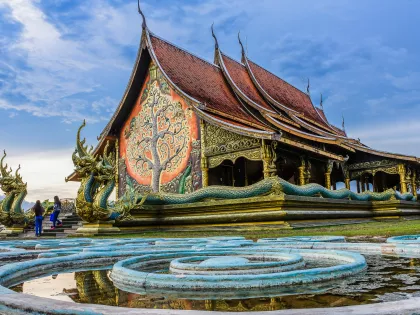A Journey Through Historical Thailand
The easiest way to understand why any country is the way we see it today is to explore its past. Explanations of the quirks of the present are so often to be found in the lessons of history, so if you’re interested in enhancing your visit through the story of how Thailand evolved, some of the answers can be found at different locations throughout the country, beginning with the dinosaurs on the northeastern plateau, and culminating with an often-overlooked site in modern Bangkok.
Prehistoric Thailand - Fossils and Dinosaurs
In the northeast of Thailand, and particularly in Khon Kaen and Kalasin provinces, Thai and French paleontologists have discovered a remarkable number of dinosaur bones, fossils, and footprints during the past four decades – some of which represent species unique to Thailand. One such sauropod, Phuwiangosaurus sirindhornae, is named after the Phu Wiang district where it was unearthed, and in honour of Princess Sirindhorn, the sister of the current Thai King. Another, Siamotyrannus isanensis, takes its name from Siam, the former name of Thailand, and Isan, the wider northeastern region of the country. Excavation work is still ongoing, and the Phu Wiang National Park hopes in the future to achieve UNESCO Global Geopark status.
Visitors today can see the Phu Wiang Fossil Research Center and Dinosaur Museum, and can also walk further into the park on marked trails to discover some of the actual excavation sites. If driving back to Khon Kaen afterwards, the Ubolratana Dam and reservoir would make for a very pleasant diversion.
10th - 13th Century - Khmer Influence
Thailand takes many of its cultural cues from neighbouring Cambodia, and in particular the Khmer Empire which once extended over a wide area incorporating parts of present-day Thailand. This influence can be seen in the northeast of the country, where a pair of Khmer temple complexes were built at the peak of the Khmer civilization, and are reminiscent of the mighty temples at Angkor in Cambodia itself. Work started on the first to be constructed in the 10th century – the Hindu temple complex at Phanom Rung, around 30 km south of Buriram. It was created initially as a shrine to Shiva, with the temple representing Mount Kailash, the sacred Himalayan peak. Similar to Angkor Wat, the construction methods make use of lightweight laterite with a sandstone exterior.
The second of these temple clusters is Phimai, located around 30 km north of Nakhon Ratchasima, the northeast region’s largest city. Work started on Phimai, one of the largest of the Khmer sites, in the 11th century, and while it is similar in style to the Angkor temples and served to honour the Hindu gods, it also incorporated strong elements of Buddhism which can be seen in the designs on the sandstone facades. Either of these sites can make for an intriguing day trip, and in comparison to a visit to Angkor across the Cambodian border, they offer a far less crowded experience on a much more manageable scale, all at a fraction of the cost.
13th - 15th Century - Sukhothai Era
As the Khmer Empire fell into decline, the Kingdom of Sukhothai was established as one of Thailand’s most significant independent city-states. It is perhaps best known for King Ramkhamhaeng, who is traditionally credited with the invention of the Thai alphabet, and whose name is today associated with the higher education sector. Ramkhamhaeng University is Thailand’s largest, with more than 430,000 students enrolled. The architectural remnants of this ancient Kingdom can be seen at the Sukhothai Historical Park, close to the city of the same name in the northern part of central Thailand. The beautifully maintained park contains the remains of the royal palace and a total of 26 temples.
14th - 18th Century - Ayutthaya Period
For more than 400 years, the Ayutthaya Kingdom was dominant in Thailand. Today the city of Ayutthaya sits 50 km north of Bangkok at the confluence of the Chao Phraya, Pasak, and Lopburi rivers, which had originally created an island site that was easy to defend. Notably, Ayutthaya saw the introduction of Theravada Buddhism as the official religion, and the establishment of the legal code which would form the basis of Thai law well into the 19th century.
The Ayutthaya period was known as the golden age of Thai art, literature, and medicine, and the Kingdom flourished through trade with the Europeans. Eventually, however, Ayutthaya fell to the Burmese in 1767, bringing an end to the era. Visitors to modern Ayutthaya will find the ruins of the Ayutthaya Kingdom at the heart of the city, largely under UNESCO protection.
18th Century - Chakri Kings
The Burmese victory of 1767 was short-lived. King Taksin arose to drive the invaders out of Siam, but fifteen years later he was removed in a coup and executed by the first of the Chakri Kings – Rama I – as the dynasty which rules to this day came to power. In 1782, the current Rattanakosin period began as Rama I took the throne and established his capital on Bangkok’s Rattanakosin Island. The Grand Palace and the Temple of the Emerald Buddha became the focus of the new Kingdom and are today major attractions for visitors to Bangkok.
20th Century - World War II
Bringing us right up to the present are our last two destinations. First is Kanchanaburi, to the west of Bangkok. Kanchanaburi makes for a fascinating day trip for anyone interested in the fate of the Allied prisoners of war who were forced by the Japanese to construct the “Death Railway” linking Bangkok to Yangon in Burma during World War II. The war cemetery in the town itself is the resting place of almost 7,000 predominantly British, Dutch, and Australian POWs who died as a result of the harsh conditions. Many more lie in graves elsewhere along the line, while it should never be forgotten that deaths among local Asian labourers outnumbered those of the prisoners by around eight to one. The excellent Death Railway Museum and Research Centre stands adjacent to the cemetery and should not be missed. To get a better idea of the realities facing the prisoners, a trip to Hellfire Pass should also be on the itinerary. This railway cutting is about half an hour north of the town and involves a short walk into the gorge from the nearby museum. This was made famous by the movie ‘Bridge over the River Kwai’ - Many foreigners pronounce the word ‘Kwai’ here rhyming with ‘sky’, but actually, the real name rhymes more closely with ‘bear’. Perhaps it should have been written ‘Bridge Over the River Khwae’.
Modern Bangkok - Struggle for Democracy
The final point on our historical journey through Thailand is in the very heart of Bangkok, within 200 metres of the Democracy Monument and Khao San Road. The 14th October Memorial stands in memory of those who lost their lives in the student uprising of 1973, which ultimately resulted in the downfall of the military dictatorship of Thanom Kittikachorn. By the official figures, 77 lives were lost as the military cracked down on student protestors using tanks and helicopters. Finally, the King stepped in, forcing Thanom to step down and move into exile. The events of October 1973 perhaps marked the beginning of a time when students and the middle classes could find their voice. Sadly, however, this was not to be the only occasion when the military would turn on the Thai people as the country continued to veer between military and civilian governments, with coup leaders replacing elected leaders and vice-versa, while a series of constitutional revisions served the interests of the government du jour.




Share-
-
-
-